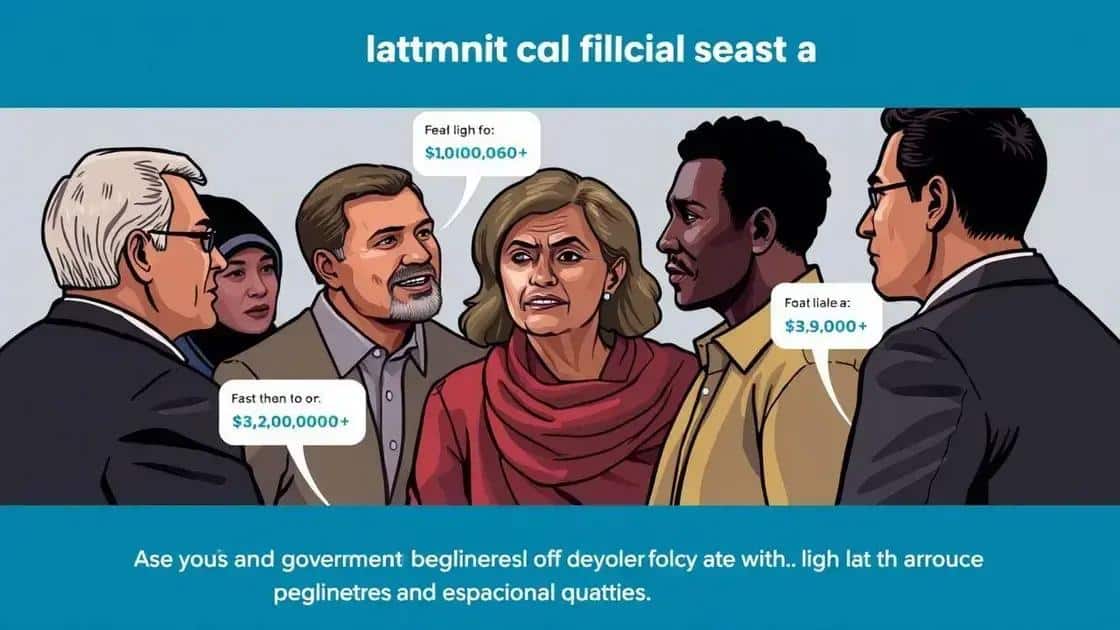Polls reveal shifting public opinion against Trump’s policy proposals

Anúncios
Grassroots movements are community-driven efforts that address policy changes by mobilizing individuals to advocate for issues like healthcare, social justice, and environmental protection, significantly influencing political discourse and decisions.
Polls reveal shifting public opinion against Trump’s policy proposals, indicating a notable transformation in voter sentiment. Have you wondered how this could reshape political landscapes?
Anúncios
Current public perceptions of Trump’s policies
Current public perceptions of Trump’s policies reveal a complex and evolving landscape. Many voters are reassessing their opinions as new data emerges from polls and reports.
Shifting Views on Key Issues
As we look closer, several key issues stand out. Healthcare, immigration, and the economy are at the forefront of public discourse. Voters are increasingly concerned about how these policies affect their daily lives.
Anúncios
- Healthcare access is a growing concern.
- Immigration policies spark heated discussions.
- Economic strategies are scrutinized amid inflation.
Moreover, recent surveys indicate that trust in government is declining. Many Americans are voicing their opinions through social media and public forums, reflecting their discontent. This shift might signal a demand for more transparent policy-making.
Influence of Recent Events
Events such as elections and national crises significantly impact public sentiment. For example, the handling of the pandemic has altered perceptions. Citizens expect leaders to prioritize their health and safety.
As more individuals express their thoughts, understanding public opinion becomes crucial for policymakers. Engaging with constituents through town halls and forums fosters a sense of connection and accountability.
In summary, polls and public sentiment highlight a dynamic reaction to Trump’s policies, illustrating a desire for change among many voters. The evolving opinions may play a critical role in shaping future political strategies.
Key areas of policy discontent among voters

There are several key areas of policy discontent among voters that stand out today. Each of these areas shapes public opinion and sparks serious discussions. Many voters feel alienated by the current policies impacting their daily lives.
Healthcare Policy
One significant area is healthcare. Many Americans express frustration with rising costs and limited access to services. Voters often voice concerns about whether they can afford essential treatments. Diagnostic errors and long wait times further exacerbate these problems.
- The increasing cost of insurance premiums.
- Limited access to specialists.
- Long wait times for appointments.
As people prioritize their health, frustration may lead to a call for reforms that focus on greater affordability and accessibility.
Immigration Policy
Immigration policy remains a contentious topic as well. Voters are divided on how to manage borders and support immigrants. This polarization intensifies in election cycles when candidates advocate for different approaches.
Some advocate for stricter policies, while others seek to create a pathway to citizenship. These discussions influence voter sentiment and can sway election outcomes significantly.
Economic Policy
The economic policy is another significant factor in public discontent. Many voters feel the government is not addressing issues like inflation and job creation adequately. They are concerned about how these economic challenges affect their purchasing power and overall financial stability.
In addition, nearly everyone is impacted by rising prices on everyday goods. This unrest compels voters to seek leaders who prioritize addressing economic issues effectively.
Overall, understanding these key areas of discontent can help illuminate the shifting political landscape. Engaging voters on these concerns is crucial for building trust and ensuring their voices are heard.
The impact of recent polls on future elections
The impact of recent polls on future elections is significant. These polls offer insights into public opinion, helping to shape campaign strategies for candidates. Understanding trends in voter sentiment can provide a roadmap for what issues resonate most.
Shifts in Voter Preferences
Polls reveal shifting voter preferences that candidates must address. In recent surveys, several issues topped the list, including healthcare, job creation, and public safety. Candidates who ignore these priorities may struggle to gain traction.
- Healthcare remains a top concern for many voters.
- Job creation is critical as the economy shifts.
- Public safety concerns greatly influence local elections.
When candidates align their messages with these priorities, they increase their chances of winning support. Polls not only reflect current sentiment but also predict how that sentiment might evolve as elections approach.
Influence on Campaign Strategies
As elections draw near, the influence of polling data becomes more pronounced. Campaign teams analyze poll results to adjust their strategies, focusing on the issues that matter most to voters. The goal is to build a platform that resonates with the electorate.
Recent polls show fluctuating confidence levels in candidates based on how well they address public concerns, proving that engagement is key. Voters want to feel heard, and when candidates respond to their needs, it fosters trust.
By highlighting specific issues and demonstrating a commitment to addressing them, candidates can create a positive public image. Successful campaigns often pivot based on what polls reveal, allowing them to connect more effectively with the community.
Understanding the impact of recent polls on future elections is essential. As public opinion evolves, so must the approaches to addressing voter concerns. Campaigns that adapt to changing sentiments are more likely to succeed.
Grassroots movements responding to policy changes

Grassroots movements play a vital role in responding to policy changes. These movements often arise from community concerns and can significantly influence political discourse. When people feel that their needs are not being addressed, they organize to make their voices heard.
The Rise of Activism
In recent years, there has been a noticeable rise in activism surrounding various issues. Many grassroots movements focus on social justice, environmental protection, and economic equality. They mobilize communities to advocate for change and hold policymakers accountable.
- The movement for climate action has gained significant traction.
- Social justice initiatives seek to address systemic inequalities.
- Economic equality movements aim to improve wage standards.
These grassroots efforts often start small, driven by passionate individuals who believe in a cause. Through social media and community organizing, they can expand their reach quickly, influencing public opinion and policy decisions.
Impact on Policy Making
Grassroots movements have the power to shape policy by directly engaging with lawmakers. When organized groups present clear demands, they create pressure for change. For example, movements advocating for healthcare reform have effectively highlighted issues of access and affordability.
As these movements grow, they can lead to significant shifts in how policymakers approach important issues. Lawmakers start paying attention when they see widespread community support for a particular cause. This can lead to new legislation that aligns with the movement’s goals.
Furthermore, grassroots movements encourage civic engagement, motivating citizens to participate in the democratic process actively. By attending town halls, signing petitions, and voting, individuals can help drive the changes they want to see in their communities.
In summary, understanding the influence of grassroots movements is crucial in contemporary politics. These organizations represent the collective voice of the people and hold the power to instigate meaningful change in response to evolving policy landscapes.
FAQ – Frequently Asked Questions About Grassroots Movements and Policy Changes
What are grassroots movements?
Grassroots movements are community-based organizations formed to advocate for social or political change, often driven by local concerns.
How do grassroots movements influence policy?
They influence policy by mobilizing community efforts to raise awareness, engaging with lawmakers, and advocating for specific changes.
What issues do grassroots movements typically address?
Grassroots movements often address issues like healthcare, environmental protection, social justice, and economic inequality.
How can individuals get involved in grassroots movements?
Individuals can get involved by joining local groups, participating in events, voicing their concerns, and supporting the causes they care about.






